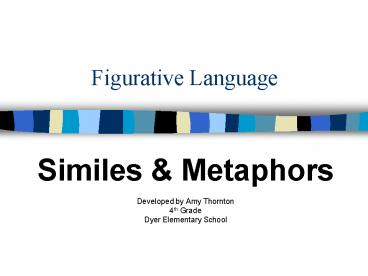Figurative Language - PowerPoint PPT Presentation
1 / 24
Title:
Figurative Language
Description:
Figurative Language Similes & Metaphors Developed by Amy Thornton 4th Grade Dyer Elementary School Similes A simile is a comparison made between two things that are ... – PowerPoint PPT presentation
Number of Views:324
Avg rating:3.0/5.0
Title: Figurative Language
1
Figurative Language
- Similes Metaphors
- Developed by Amy Thornton
- 4th Grade
- Dyer Elementary School
2
Similes
- A simile is a comparison made between two things
that are not alike in most ways, but are alike in
one important way.
3
Similes
- In a simile, the words like or as are used to
signal that a comparison is being made between
the two things.
4
Similes
- Speakers and writers use similes to emphasize a
certain characteristic of a thing.
5
Similes
- The comparison made in a simile is often unusual.
- The listener or reader can form a mental image of
the comparison. - This increases understanding of what the speaker
or writer is trying to communicate.
6
Similes
- Last night Bob slept like a log.
7
Similes
- Working on her project, Mary was as busy as a
beaver.
8
Commonly used Similes with like
fits like a gloveruns like a deerchatters like
a monkeymoves like a snailsits there like a
bump on a logeats like a pigswims like a
fishstood out like a sore thumbfought like cats
and dogseyes like a hawktakes it like a
mansings like a bird
9
Commonly used Similes with as
as clear as mudas strong as an oxas nutty as a
fruitcakeas pretty as a pictureas good as
goldas quiet as a mouseas clear as a bellas
bright as dayas light as a featheras dry as a
boneas slow as molassesas deep as the ocean
10
Similes
- You will often encounter similes when listening
to a speaker or reading something.
11
Similes
- Follow the steps listed below to build your
understanding of similes. - Listen or look for the words like or "as" as
clues to a possible simile. - Identify the two things being compared.
- Think about the two things being compared.
- Form a mental image of the comparison.
- Identify what the speaker or writer is trying to
communicate.
12
Similes
- Recognizing similes will help you better
understand what you hear or read. - Using similes when you speak or write will
improve your communication.
13
Metaphors
- A metaphor is a figure of speech in which a word
or phrase that denotes a certain object or idea
is applied to another word or phrase to imply
some similarity between them.
14
Metaphors
- The inside of the car was a refrigerator.
- A refrigerator is very cold. In this example,
refrigerator is a metaphor because it is being
applied to the inside of the car to imply that
the inside of the car was very cold.
15
Metaphors
- The teenage boys stomach was a bottomless pit.
- A bottomless pit can never be filled. In this
example, bottomless pit is a metaphor because
it is being applied to the teenage boys
stomach to imply that his appetite could never
be satisfied (that is, his stomach could never be
filled).
16
Metaphors
- Speakers and writers use metaphors for several
reasons - Metaphors can help readers or listeners to better
understand something about the object or idea to
which the metaphor is being applied. - Metaphors can make speaking and writing more
lively and interesting. - Metaphors can communicate a great deal of meaning
with just a word or a phrase. - Metaphors, because they imply rather than
directly state relationships, can get listeners
and readers to think about what they are hearing
or reading.
17
Metaphors
- The teacher got to the bottom of the problem.
(This implies that the teacher got to the source
of the problem.)
18
Metaphors
- My dad was boiling mad. (This implies that my
dad was very, very angry.)
19
Metaphors
- The homework was a breeze. (This implies that the
homework was very easy to do.)
20
Metaphors
- They showered the birthday girl with gifts. (This
implies that they gave the girl many gifts.)
21
Metaphors
- Her dog, Jake, was the sunshine of her life.
(This implies that Jake was the brightest or best
part of her life.)
22
A Strategy for using Metaphors
- Identify the object or idea that is the subject
of what you are writing or saying. For example,
suppose you are trying to describe a sunset. - Identify what it is you want to communicate about
that object or idea. You want to bring out how
beautiful the sunset is. - Identify another object or idea that strongly
implies what you want to communicate. You decide
that the idea of painted would be a good way to
communicate the beauty of the sunset. - Construct a sentence in which you link the idea
of painted with sunset. For example, you could
write or say, The sunset painted the sky with
vibrant colors.
23
Metaphors
- Using metaphors when you write and speak will
allow you to communicate more effectively and in
a more interesting way.
24
Similes Metaphors
- Lets watch a BrainPop about these kinds of
figurative language! - Log in and search for Similes.































